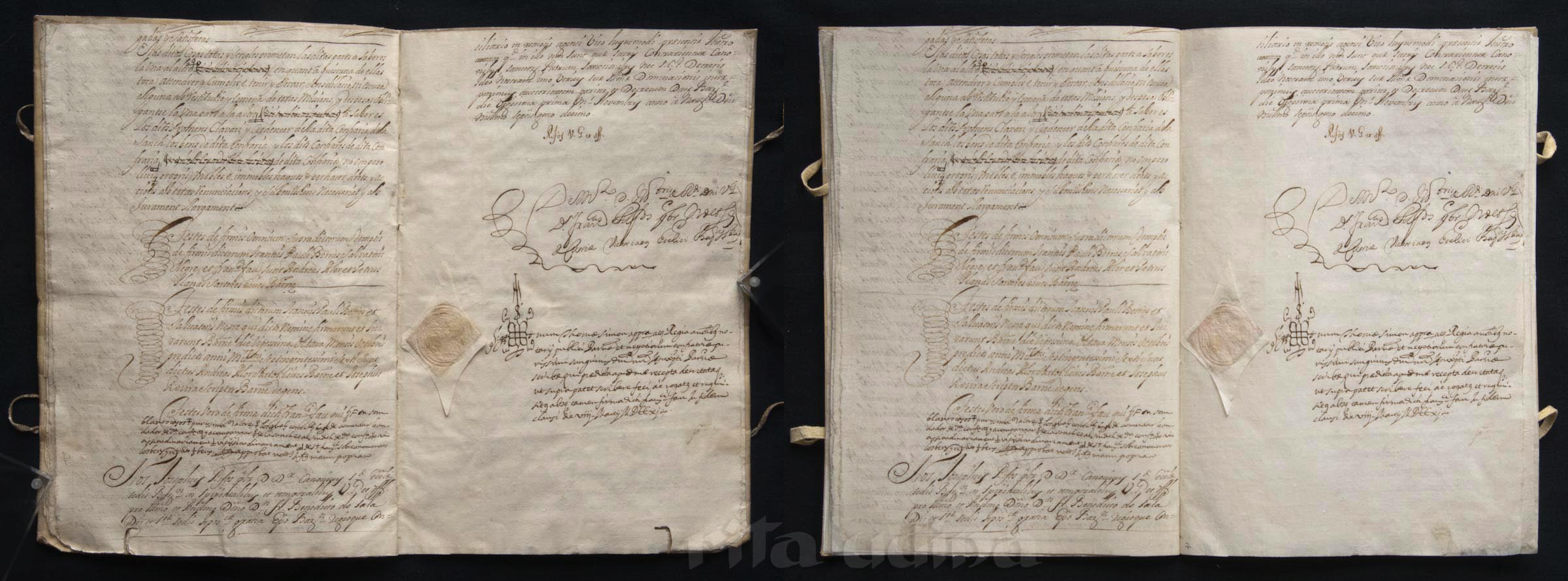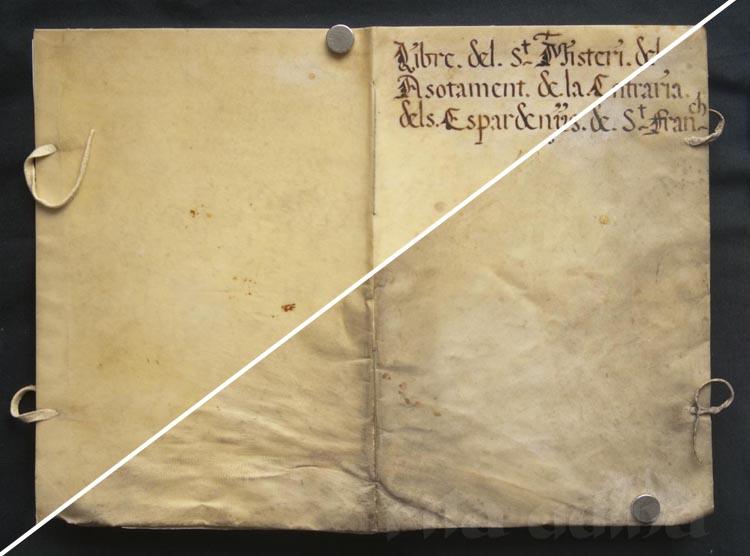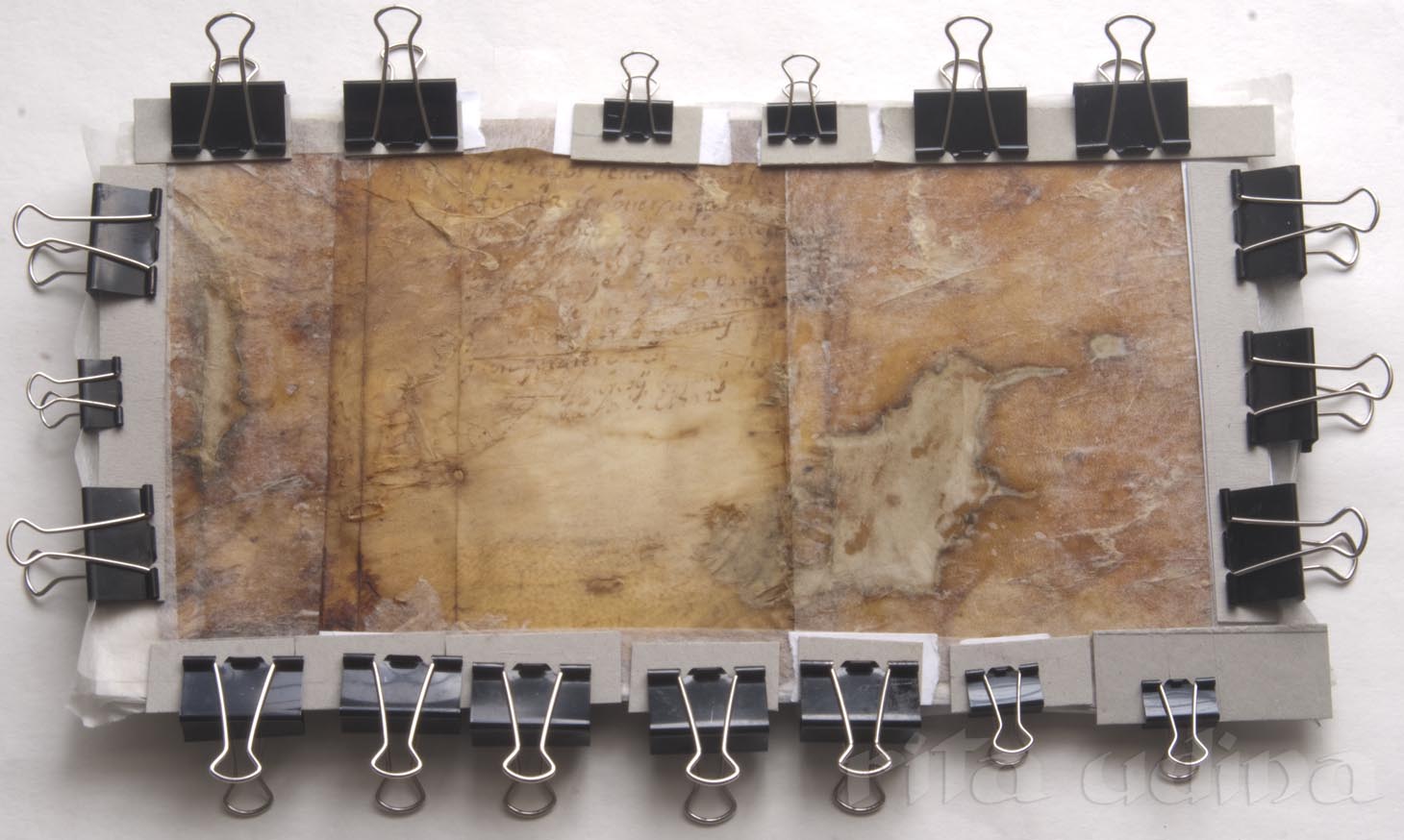Flattening under tension on paper and parchment conservation
Creases and folds are a usual damage in documents made of paper, cloth or parchment. The common way to restablish these supports to its original condition is by pressure: under weights or in a press.
When the paper has a relief which must be preserved, it is then not possible to use pressure, as it would smash this relief. That is the case forinstnace of imprint marks, wax and dry seals.
Dry seals on paper.
Flattening under tension may be an interesting alternative on certain occasions or when a selective flattened is needed. It takes advantage of the natural shrinkage of the paper when going from wet to dry, so that the tension is given by the same paper. The conservator can regulate the intensity by varying the initial humidity degree. The more wet is the paper at the beginning, the more it will shrink as it dries, so much greater will the tension be. If, however, the sheet is only slightly damp, tension will be moderated. Depending on the type of support and the intensity of wrinkles and/or folds, we might want to do one way or the other. Watch out! if this valuation is not accordingly measured, the paper will tear apart!
There are variants of the same system depending on the fastening of the paper, cloth or parchment. It can be done by pressure (bulldog clips, magnets), or by adhering the edges to a rigid support (with paper strips, threads, or other elements)… creativity just opens wider possibilities.
In the case of the wax seal of this bundle – Llibre del sant misteri del asotament de la Confraria dels espardenyers de Sant Fran [ces] ch – magnets were used. After washing and deacidificating, sheets were dried by airing, becoming then undulated in an irregular and capricious way. After this cleaning and drying, then the flattening under tension is applied.
The gray surface is iron, the white on is a blotting paper, and rectangular and circular shapes are magnets that hold the paper on the metal plate. Final stage of flattening under tension, previously spraying some water on the paper with the masked seal. Municipal Archive of Barcelona, Sants-Montjuïc District.
The paper is placed on a metal surface (there may be a blotting paper underneath) holding the perimeter with magnets and applying moderate pressure, that one enabled by the dry paper. Then the paper is then moisturized by spraying water. At this point it becomes loose, and it flattens as it dries. Tension is naturally and evenly regulated. The seal was avoided on the spraying, as this area was intended to be kept as it was. It is a quick method that requires no previous preparations.
“Llibre del Sant Misteri del asotament de la Confraria dels espardenyers de Sant Fran[ces]ch” with wax seal. Left: before conservation. Right: after conservation. Municipal Archive of Barcelona, Sants-Montjuïc District.
Flattening under tension is very advantageous when the same document has areas with different dimensional stability, that is, they shrink and expand differently. An example is a wax seal (since the sealed part is rigid while the rest of the paper remains flexible). An other example is parchment support, which is a natural membrane. A hide is never even: the same surface has diversity of thicknesses and also diverse elasticity. No need to remember that pigs or a sheeps are not flat, they are bulgy and three-dimensional, and if we do nothing, these leathers tend to recover its original shape. Flattened under tension tightens more on more flexible areas, and is more resilient on more rigid areas, while no need to do any adjustment on the system.
Parchment covers of the limp binding for “Llibre del Sant Misteri del asotament de la Confraria dels espardenyers de Sant Fran[ces]ch”. Photo montage of the previous state (right image) and after the restoration (left image). Municipal Archive of Barcelona, Sants-Montjuïc District.
The parchment covers were carefully treated in the same way, also because of the manuscript writting. There was plenty of dirt on the surface which was treated with water, masking the written part. The ink was protected during wet treatment by means of fixation. The moisture degree involved on the somewhat wet cleaning was subsequently followed by the flattening under tension.
This method ensures -unlike flattened under weight- no migration of ink to blotting papers. So whether the document is written on both sides, or only one, no pressure on the ink layer is held. Pressure is exercised side to side, and not top to bottom. Manuscript inks on parchment are very sensitive to aqueous treatments, and therefore a very careful is needed in order not to loose or lessen the ink layer.
Detail of the parchment cover during the fixing of the ink title on the limp binding. Municipal Archive of Barcelona, Sants-Montjuïc District.
When, in addition to the irregular supports, there are several materials, the different dimensional stability varies even more, precisely between different materials. As an example, this limp parchment binding where the loss was infilled with dyed paper.
Left: Rumple limp parchment binding with considerable losses on the covers which interfere to the stitched sewing (at the top). The holes for the fastening of the lock were also on the lost area. The button is lost, remaining only the tie (at the right). Right: Limp binding after conservation. Losses have been infilled with Japanese paper dyed beforehand. Private collection.
On this ocasion the treatment departed from an initial stage with a bigger quantity of moisture. The fastening was done with clips, not magnets. And instead of a metal plate a carboard was used, the usual for clips. The drawback is that a cardboard must be cut to size for each artefact, but has the advantage that it is safer for delicate materials (such as this one, which had a profusion of tears and losses that could be endangered). If tension is too high, the cardboard tells us becoming undulated, something that a metal plate would never do when a skin or paper stretched on it. The iron plate would remain intact and the weak supports break or tear apart! If that happened, it means that the tennsion was far too strong. Private collection.
Flattening under tension with clips fastened all along the perimeter. Under the parchment there is a blotting paper and a cardboard. Private collection.
Tension can be modulated as the parchment is being flattened, while it shrinks, by means of adjusting the position of the clips, or even shrinking the area of the cardboard.
Filter post by:
Flattening under tension on paper and parchment conservation
Creases and folds are a usual damage in documents made of paper, cloth or parchment. The common way to restablish these supports to its original condition is by pressure: under weights or in a press.
When the paper has a relief which must be preserved, it is then not possible to use pressure, as it would smash this relief. That is the case forinstnace of imprint marks, wax and dry seals.
Dry seals on paper.
Flattening under tension may be an interesting alternative on certain occasions or when a selective flattened is needed. It takes advantage of the natural shrinkage of the paper when going from wet to dry, so that the tension is given by the same paper. The conservator can regulate the intensity by varying the initial humidity degree. The more wet is the paper at the beginning, the more it will shrink as it dries, so much greater will the tension be. If, however, the sheet is only slightly damp, tension will be moderated. Depending on the type of support and the intensity of wrinkles and/or folds, we might want to do one way or the other. Watch out! if this valuation is not accordingly measured, the paper will tear apart!
There are variants of the same system depending on the fastening of the paper, cloth or parchment. It can be done by pressure (bulldog clips, magnets), or by adhering the edges to a rigid support (with paper strips, threads, or other elements)… creativity just opens wider possibilities.
In the case of the wax seal of this bundle – Llibre del sant misteri del asotament de la Confraria dels espardenyers de Sant Fran [ces] ch – magnets were used. After washing and deacidificating, sheets were dried by airing, becoming then undulated in an irregular and capricious way. After this cleaning and drying, then the flattening under tension is applied.
The gray surface is iron, the white on is a blotting paper, and rectangular and circular shapes are magnets that hold the paper on the metal plate. Final stage of flattening under tension, previously spraying some water on the paper with the masked seal. Municipal Archive of Barcelona, Sants-Montjuïc District.
The paper is placed on a metal surface (there may be a blotting paper underneath) holding the perimeter with magnets and applying moderate pressure, that one enabled by the dry paper. Then the paper is then moisturized by spraying water. At this point it becomes loose, and it flattens as it dries. Tension is naturally and evenly regulated. The seal was avoided on the spraying, as this area was intended to be kept as it was. It is a quick method that requires no previous preparations.
“Llibre del Sant Misteri del asotament de la Confraria dels espardenyers de Sant Fran[ces]ch” with wax seal. Left: before conservation. Right: after conservation. Municipal Archive of Barcelona, Sants-Montjuïc District.
Flattening under tension is very advantageous when the same document has areas with different dimensional stability, that is, they shrink and expand differently. An example is a wax seal (since the sealed part is rigid while the rest of the paper remains flexible). An other example is parchment support, which is a natural membrane. A hide is never even: the same surface has diversity of thicknesses and also diverse elasticity. No need to remember that pigs or a sheeps are not flat, they are bulgy and three-dimensional, and if we do nothing, these leathers tend to recover its original shape. Flattened under tension tightens more on more flexible areas, and is more resilient on more rigid areas, while no need to do any adjustment on the system.
Parchment covers of the limp binding for “Llibre del Sant Misteri del asotament de la Confraria dels espardenyers de Sant Fran[ces]ch”. Photo montage of the previous state (right image) and after the restoration (left image). Municipal Archive of Barcelona, Sants-Montjuïc District.
The parchment covers were carefully treated in the same way, also because of the manuscript writting. There was plenty of dirt on the surface which was treated with water, masking the written part. The ink was protected during wet treatment by means of fixation. The moisture degree involved on the somewhat wet cleaning was subsequently followed by the flattening under tension.
This method ensures -unlike flattened under weight- no migration of ink to blotting papers. So whether the document is written on both sides, or only one, no pressure on the ink layer is held. Pressure is exercised side to side, and not top to bottom. Manuscript inks on parchment are very sensitive to aqueous treatments, and therefore a very careful is needed in order not to loose or lessen the ink layer.
Detail of the parchment cover during the fixing of the ink title on the limp binding. Municipal Archive of Barcelona, Sants-Montjuïc District.
When, in addition to the irregular supports, there are several materials, the different dimensional stability varies even more, precisely between different materials. As an example, this limp parchment binding where the loss was infilled with dyed paper.
Left: Rumple limp parchment binding with considerable losses on the covers which interfere to the stitched sewing (at the top). The holes for the fastening of the lock were also on the lost area. The button is lost, remaining only the tie (at the right). Right: Limp binding after conservation. Losses have been infilled with Japanese paper dyed beforehand. Private collection.
On this ocasion the treatment departed from an initial stage with a bigger quantity of moisture. The fastening was done with clips, not magnets. And instead of a metal plate a carboard was used, the usual for clips. The drawback is that a cardboard must be cut to size for each artefact, but has the advantage that it is safer for delicate materials (such as this one, which had a profusion of tears and losses that could be endangered). If tension is too high, the cardboard tells us becoming undulated, something that a metal plate would never do when a skin or paper stretched on it. The iron plate would remain intact and the weak supports break or tear apart! If that happened, it means that the tennsion was far too strong. Private collection.
Flattening under tension with clips fastened all along the perimeter. Under the parchment there is a blotting paper and a cardboard. Private collection.
Tension can be modulated as the parchment is being flattened, while it shrinks, by means of adjusting the position of the clips, or even shrinking the area of the cardboard.









